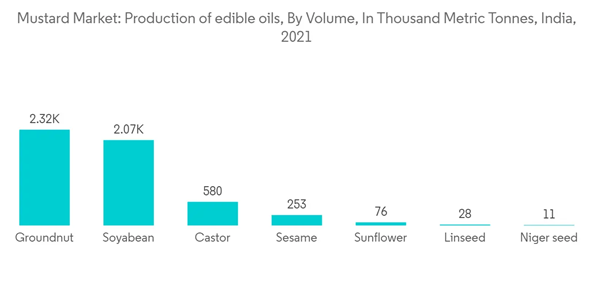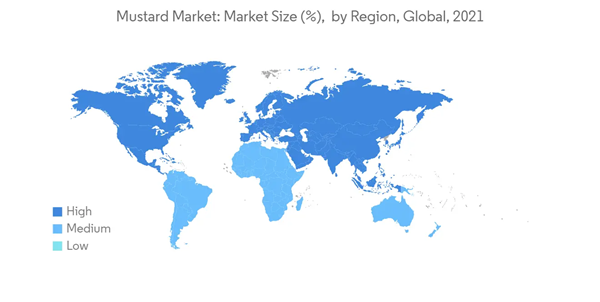The Mustard Market size is estimated at USD 6.87 billion in 2024, and is expected to reach USD 9.10 billion by 2029, growing at a CAGR of 5.80% during the forecast period (2024-2029).
According to data provided by National Commodity & Derivatives Exchange Limited, it is a significant oilseed crop that produces roughly 14% of the world's vegetable oil production. After palm and soybean oil, mustard is among the top three vegetable oil sources (NCDEX). India is the leading producer of mustard in Asia, and mustard oil is the principal cooking oil in Indian cuisine. At the same time, the uses for the defatted mustard cake include animal feed and fertilizer. The market is projected to be significantly increasing for mustard oil in the upcoming years because mustard seeds are increasingly used in food and beverage, pharmaceutical, personal care, cosmetic, and other industries.
Mustard seed is another excellent source of protein. This crop's seed is also high in fiber, erucic acid, palmitic acid, tocopherols, tocotrienols, carotene, oryzanol, squalene, and thiamine, among other minerals, vitamins, antioxidants, and phytonutrients.
COVID-19 had a significant effect on the market. This was due to the health benefits that the mustard carries with it, such as blocking microbial growth, promoting skin health, reduces inflammation. The consumer's consciousness towards the health benefits has tremendously dragged the per capita spending towards the mustard market. McCormick & Company, which is one the major players in the industry, has estimated growth of 26% in sales of french's mustard during fiscal 2021.
Currently, scientists are looking for nitrate-free alternatives to preserve meat products. The shelf life of meatballs can be increased by mixing ground mustard into the mixture. White mustard-based products received a better sensory review than controls or those made with black and brown mustard. The inclusion of mustard efficiently stops microbial growth in the final product. Therefore, mustard has vast application opportunities.
With almost three million metric tonnes produced during the fiscal year 2021, mustard accounted for the largest portion of all edible oils produced in India. Mustard can be utilized as a spring oil plant because of its high-fat content. Because it gives meals a fiery, spicy flavor, mustard oil is utilized in cooking. Asia, particularly India and China, is where it is most widely used.
This product will be delivered within 2 business days.
According to data provided by National Commodity & Derivatives Exchange Limited, it is a significant oilseed crop that produces roughly 14% of the world's vegetable oil production. After palm and soybean oil, mustard is among the top three vegetable oil sources (NCDEX). India is the leading producer of mustard in Asia, and mustard oil is the principal cooking oil in Indian cuisine. At the same time, the uses for the defatted mustard cake include animal feed and fertilizer. The market is projected to be significantly increasing for mustard oil in the upcoming years because mustard seeds are increasingly used in food and beverage, pharmaceutical, personal care, cosmetic, and other industries.
Mustard seed is another excellent source of protein. This crop's seed is also high in fiber, erucic acid, palmitic acid, tocopherols, tocotrienols, carotene, oryzanol, squalene, and thiamine, among other minerals, vitamins, antioxidants, and phytonutrients.
COVID-19 had a significant effect on the market. This was due to the health benefits that the mustard carries with it, such as blocking microbial growth, promoting skin health, reduces inflammation. The consumer's consciousness towards the health benefits has tremendously dragged the per capita spending towards the mustard market. McCormick & Company, which is one the major players in the industry, has estimated growth of 26% in sales of french's mustard during fiscal 2021.
Currently, scientists are looking for nitrate-free alternatives to preserve meat products. The shelf life of meatballs can be increased by mixing ground mustard into the mixture. White mustard-based products received a better sensory review than controls or those made with black and brown mustard. The inclusion of mustard efficiently stops microbial growth in the final product. Therefore, mustard has vast application opportunities.
Mustard Market Trends
Rising Awareness about Health Benefits from Mustard Consumption
With the changing lifestyle, consumers tend to prefer a healthier lifestyle. The demand for mustard has been increasing over the years. This is mainly due to the significance of mustard as a health-beneficial product, such as mustard seeds which can kill cancer cells. Moreover, the wide range of mustard seed applications includes flavoring agents in different food dishes, mayonnaise and dips, preparing condiments such as table mustard, and many more that drive this market segment. Also, mustard oil and organic mustard seeds are the current trends that further boost the global mustard market. In addition, having therapeutic benefits, mustard herb & oil has been in rising demand. Among the various varieties offered, demand for Yellow Mustard sauce is higher as compared to Dijon, Spicy/Brown, Honeymustard, and Horseradish due to its wide range of applications in the food industry that includes its use as having flavoring agent in salad dishes, mayonnaise, and dips, preparing condiments such as table mustard.Asia-Pacific is the Fastest-Growing Market
Asia-Pacific is the fastest-growing mustard market. The region is elevating due to the rising demand for mustard by consumers. the countries like China and India play a significant role in mustard production in the region. According to Central Organization for Oil Industry and Trade (COOIT), India has an estimated 85 lakh tonnes in the 2020-21 crop year (July-June), the production is still accelerating due to the increasing demand for mustard all over the globe. The utilization of mustard varies from country to country with the region. In India, the major utilization of mustard is by mustard oil and in preparation of spices for various cuisines, whereas, in China, the consumers use mustard leaves for consumption as well, the leaf is used in salad, blending into a smoothie, soups, and stews, and roasted leaves of mustard seasoned with garlic and spices are eventually used as side-dish for numerous cuisines in the respective country. The major demand for mustard and mustard-based products is due to the increasing awareness of health benefits that can be gained by consuming these products is one major reason that is driving the market.With almost three million metric tonnes produced during the fiscal year 2021, mustard accounted for the largest portion of all edible oils produced in India. Mustard can be utilized as a spring oil plant because of its high-fat content. Because it gives meals a fiery, spicy flavor, mustard oil is utilized in cooking. Asia, particularly India and China, is where it is most widely used.
Mustard Industry Overview
The market studied is competitive due to the presence of domestic and international players in the segment. Some of the major players in the global mustard market include Backwoods Mustard Company, Woeber Mustard Manufacturing Company., McCormick & Co., Conagra Brands Inc., and Unilever. Most companies are actively involved in product innovation along with mergers and acquisitions, owing to globalization, since the leading global companies have a considerable share within the industry. The strategy behind mergers and acquisitions also enables these top players to sustain dominance over other regional players in the industry.Additional Benefits:
- The market estimate (ME) sheet in Excel format
- 3 months of analyst support
This product will be delivered within 2 business days.
Table of Contents
1 INTRODUCTION
4 MARKET DYNAMICS
5 MARKET SEGMENTATION
6 COMPETITIVE LANDSCAPE
Companies Mentioned (Partial List)
A selection of companies mentioned in this report includes, but is not limited to:
- Backwoods Mustard Company
- Mustard and Co.
- Woeber Mustard Manufacturing Company
- Unilever
- Boar's Head Brand
- Bertman Foods Co.
- Colman's of Norwich
- McCormick & Company, Inc.
- Conagra Brands Inc.
- The Kraft Heinz Company
Methodology

LOADING...










